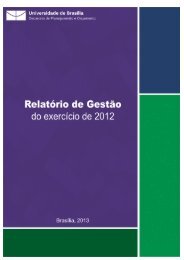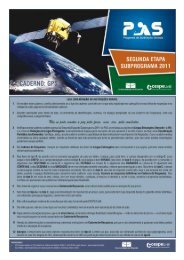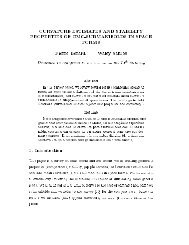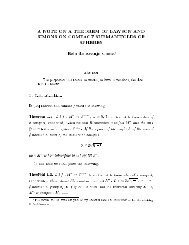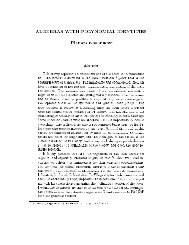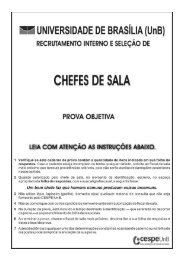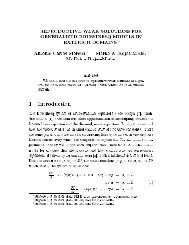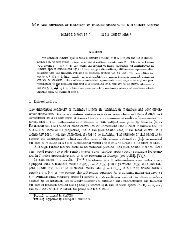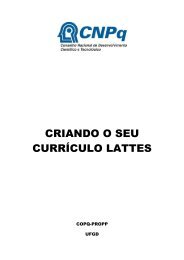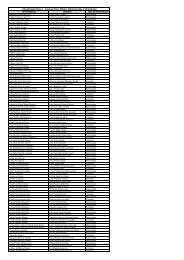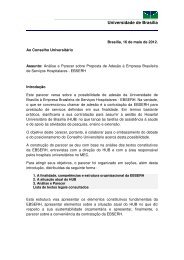A Genetic Approach with a Simple Fitness Function for Sorting ...
A Genetic Approach with a Simple Fitness Function for Sorting ...
A Genetic Approach with a Simple Fitness Function for Sorting ...
- No tags were found...
Create successful ePaper yourself
Turn your PDF publications into a flip-book with our unique Google optimized e-Paper software.
A <strong>Genetic</strong> <strong>Approach</strong> <strong>with</strong> a <strong>Simple</strong> <strong>Fitness</strong> <strong>Function</strong><br />
<strong>for</strong> <strong>Sorting</strong> Unsigned Permutations by Reversals<br />
José Luis Soncco Álvarez<br />
Department of Computer Science<br />
University of Brasilia<br />
Brasilia, D.F., Brazil<br />
Email: josesoal@hotmail.com<br />
Mauricio Ayala-Rincón<br />
Departments of Computer Science and<br />
Mathematics, University of Brasilia<br />
Brasilia, D.F., Brazil<br />
Email: ayala@unb.br<br />
Abstract—<strong>Sorting</strong> unsigned permutations by reversals is an<br />
important and difficult problem in combinatorial processing<br />
of permutations <strong>with</strong> important applications in bio-in<strong>for</strong>matics<br />
<strong>for</strong> the interpretation of the evolutionary relationship between<br />
organisms. Since it was shown that the problem is NP-hard<br />
many approximation and a few evolutionary algorithms were<br />
proposed. In this paper we propose a new genetic algorithm<br />
approach that uses modified crossover and mutation operators<br />
adapted to the problem. Instead previous genetic algorithmic<br />
approaches, the proposed algorithm uses a very simple fitness<br />
function that can be linearly computed in the size of the<br />
permutation and updated in constant time, <strong>for</strong> each individual<br />
in each generation. In order to compare the accuracy of the<br />
computed solutions, an 1.5 approximation ratio algorithm was<br />
developed by fixing Christie’s approximation method. The results<br />
showed that on average the proposed genetic approach produces<br />
competitive results in relation <strong>with</strong> the ones given by the 1.5-<br />
approximation algorithm. Additionally, it has been observed that<br />
<strong>for</strong> permutations of all sizes, that were randomly generated, it was<br />
alway possible to compute better solutions <strong>with</strong> the genetic than<br />
<strong>with</strong> the approximate approach and that the difference obtained<br />
<strong>for</strong> these cases is greater than the ones obtained in the cases<br />
in which the genetic approach has a worse behavior than the<br />
approximate one.<br />
I. INTRODUCTION<br />
The evolutionary relationship of two organisms can be determined<br />
by comparing two biological sequences, but classical<br />
algorithms only take into account local mutations (deletions,<br />
insertions and substitutions) and do not consider global rearrangements<br />
(reversals, transpositions, translocations, etc).<br />
Reversals are the most commonly observed mechanisms of<br />
genome rearrangements to trans<strong>for</strong>m one genome into another.<br />
The order of genes in a genome can be represented as a<br />
permutation π = (π 1 , π 2 , . . . , π n ) of the set {1...n} where n<br />
is the number of genes. There are two types of permutations:<br />
signed and unsigned permutations. On signed permutations,<br />
each π i has a positive or negative sign reflecting its orientation<br />
<strong>with</strong>in the genome.<br />
Given two permutations we wish to determine the minimum<br />
number of reversals to trans<strong>for</strong>m one permutation into another,<br />
that is the reversal distance between two permutations. If one<br />
of the permutations is the identity permutation (permutation<br />
sorted in increasing order), the problem is known as sorting<br />
by reversals.<br />
For the problem of sorting signed permutation, initially, Kececioglu<br />
and Sankoff [1] conjectured that the problem was NPhard<br />
and proposed a 2-approximation algorithm. Afterwards,<br />
Bafna and Pevzner [2] improved the radio to 1.5, by using<br />
the data structure of breakpoint graphs. Finally, Hannenhalli<br />
and Pevzner [3] gave an exact polynomial (O(n 4 )) algorithm.<br />
Further, more efficient algorithms have been introduced (e.g.,<br />
[4], [5]).<br />
For unsigned permutations, that are the ones treated in this<br />
paper, the problem was shown to be NP-hard by Caprara [6].<br />
Be<strong>for</strong>e the complexity was known, Kececioglu and Sankoff<br />
[1] gave a 2-approximation algorithm. Later on, the radio was<br />
improved to 1.5 by Christie [7] and then to 1.375 by Berman,<br />
Hannenhalli and Karpinski [8]. The last approximation algorithm<br />
is of theoretical interest being its practical implementation<br />
of great difficulty. Thus, in this paper we have fixed<br />
some imprecisions in Christie 1.5-approximation approach,<br />
that were not pointed out by other authors dealing <strong>with</strong> this<br />
approximation algorithm as a control mechanism <strong>for</strong> genetic<br />
solutions. The resulting 1.5-approximation algorithm has been<br />
directly implemented in order to have an accurate mechanism<br />
of control of the solutions computed by the proposed genetic<br />
approach.<br />
Because of its complexity, exploration of evolutionary algorithms<br />
<strong>for</strong> the problem of sorting unsigned permutations<br />
by reversals is of great interest. Auyeung and Abraham [9]<br />
suggested a genetic algorithmic (GA) approach to solve the<br />
problem of sorting unsigned permutations by reversals based<br />
on mapping unsigned permutations of size n into a subset<br />
of the 2 n possible signed versions of the permutations. For<br />
a given unsigned permutation, a set of signed permutations is<br />
generated by randomly assigning either a positive or a negative<br />
signal to each component of the permutation. An exact sorting<br />
solution of a signed version of a permutation corresponds to<br />
an approximate sorting solution of the unsigned permutation.<br />
The fitness function of each signed permutation is given by<br />
its exact reversal distance that is computed by Hannenhalli’s<br />
et al. method. Using GA techniques this combinatorial space<br />
is explored. Subsequently improvements to Auyeung’s et al<br />
method were published in [10], but <strong>with</strong>out changing the<br />
central premisses of this approach. More recently, Ghaffarizadeh,<br />
Ahmadi and Flann [11] used a modified version of
the standard GA using individuals of different sizes to reduce<br />
the runtime of the algorithm. All these approaches have been<br />
reported to improve the results obtained applying Christie’s<br />
1.5-approximation algorithm, but no mention was given on<br />
the imprecisions presented neither in Christie’s original paper<br />
nor in its subsequently published erratum.<br />
In this paper we propose a new GA approach, which<br />
initially, uses individuals of the same ”size” to find a good<br />
solution and, after that, the mutation operator is used generating<br />
permutations of different ”sizes” in order to improve<br />
the first computed solution. The distinguished feature of<br />
this GA approach, is that individuals correspond to partial<br />
approximate sorting by reversal solutions. Since incomplete<br />
solutions need to be compared, a simple fitness function is<br />
given by the addition of the number of ”breakpoints” in the<br />
current permutation plus the number of reversals that were<br />
applied in order to obtain the current unsigned permutation.<br />
This fitness function can either be computed from scratch in<br />
linear time or updated in constant time in the size of the<br />
permutation. In this way, the expensive runtime necessary<br />
to compute the fitness function applied in the approaches in<br />
[9], [10], [11] is avoided. In order to compare the computed<br />
sorting solutions, Christie’s 1.5-approximation algorithm was<br />
adequately implemented fixing some cases that were not<br />
considered in [7]. Although Berman’s et al algorithm has<br />
a better approximation ratio, its implementation is not of<br />
practical interest, as previously mentioned, because it requires<br />
a great deal of ef<strong>for</strong>t <strong>with</strong>out producing a competitive runtime<br />
mechanism of control. Experiments showed that on average the<br />
results obtained though the proposed GA approach are similar<br />
to the ones obtained through the 1.5-approximation algorithm.<br />
For all size of permutations checked, cases <strong>for</strong> which the GA<br />
approach works better and worse than the 1.5-approximation<br />
algorithm were found, but in average the computed sorting<br />
solutions are in favor of the GA approach.<br />
The paper is organized in the following sections: in Section<br />
II, the necessary notations and notions as well as the 1.5-<br />
approximation algorithm implemented as control are given; in<br />
Section III, the proposed GA approach is presented; in Section<br />
IV, experiments and results are given; in Section V, the method<br />
and the results are discussed and; finally concluding remarks<br />
are discussed in Section VI.<br />
The reversal ρ(2, 4) trans<strong>for</strong>ms π into<br />
π ′ = (0, 3, 2, 5, 1, 4, 6)<br />
Note that the reversal reverts the interval [2, 4] of π.<br />
Given two permutations π and σ, the reversal distance<br />
problem is the problem of finding a shortest sequence of<br />
reversals needed to trans<strong>for</strong>m π into σ. The reversal distance<br />
between π and σ is the minimum number of reversals required<br />
to trans<strong>for</strong>m π into σ.<br />
By simple algebraic properties of symmetry groups, the<br />
reversal distance between π and σ is equal to the reversal<br />
distance between σ −1 π and the identity permutations, that is<br />
denoted as id. In fact, notice that if ρ 1 . . . ρ k , is a sequence of<br />
(reversal) permutations, then it holds that πρ 1 . . . ρ k = σ, if<br />
and only if (σ −1 π)ρ 1 . . . ρ k = σ −1 σ = id. Thus, the problem<br />
of sorting by reversals corresponds to find the reversal distance<br />
between a permutation π and the identity permutation id, that<br />
is denoted as d(π).<br />
Let i ∼ j denote the property |i − j| = 1. Given two<br />
consecutive elements π i and π j of π, <strong>for</strong> 0 < i < n + 1<br />
and either j = i − 1 or j = i + 1,<br />
• they are said to be adjacent if π i ∼ π j and<br />
• they are said to <strong>for</strong>m a breakpoint if π i ≁ π j .<br />
Observe that the identity permutation is the unique permutation<br />
<strong>with</strong>out breakpoints. The number of breakpoints in π is<br />
denoted by b(π).<br />
Let ρ be a reversal that trans<strong>for</strong>ms π into π ′ , then b(π) −<br />
b(π ′ ) ∈ {−2, −1, 0, 1, 2}.<br />
Given a permutation π, one defines a cycle graph (also<br />
called as breakpoint graph) , G(π) as a undirected edgecolored<br />
graph derived from the adjacency and breakpoint<br />
relations in π <strong>with</strong> n + 2 vertices labeled by 0, 1, . . . , n, n + 1.<br />
Two vertices i and j are joined by a black edge if (i, j) is a<br />
breakpoint of π. Two vertices i and j are joined by a gray<br />
edge if i ∼ j and i, j are not consecutive in π. An example<br />
of a cycle graph is shown in Fig.1.<br />
II. BACKGROUND<br />
A. Terminology<br />
All definitions and terminology presented below, were introduced<br />
by Bafna and Pevzner in their seminal paper [2].<br />
Given a permutation π = (π 1 , π 2 , . . . , π n ) in the symmetry<br />
group S n , we extend its definition by adding initial and final<br />
pivots π 0 = 0 and π n+1 = n + 1. A reversal ρ(i, j) of an<br />
interval [i, j], <strong>for</strong> 1 ≤ i ≤ j ≤ n, trans<strong>for</strong>ms the extended<br />
permutation π into π ′ = (π 0 , . . . , π i−1 , π j , . . . , π i , . . . , π n+1 ).<br />
For example, consider the permutation<br />
π = (0, 3, 1, 5, 2, 4, 6)<br />
Fig. 1. Cycle graph G(π) <strong>for</strong> the permutation π = (7, 2, 1, 3, 4, 5, 6)<br />
Note that <strong>for</strong> all permutations π, G(π) can be completely<br />
decomposed into disjoint cycles of alternated colored edges,<br />
since each node has an equal number of black and gray<br />
incident edges. However, there are probably many different<br />
cycle decompositions of G(π) of alternated colored edges. For<br />
simplicity, cycles of alternating colored edges will be called<br />
either alternating cycles or simply cycles.
B. 1.5-Approximation algorithm <strong>for</strong> sorting by reversals<br />
The development of the 1.5-approximation algorithm requires<br />
another graph, called reversal graph, that is used in<br />
order to find the sequence of sorting reversals. Given a permutation<br />
π, and a particular cycle decomposition C of the cycle<br />
graph, the reversal graph R(C) is constructed correspondingly<br />
to the cycle decomposition C following the method presented<br />
in [7].<br />
Each vertex i of the reversal graph represents a possible<br />
reversal embedded in the gray edge (i, i+1) of the cycle graph.<br />
A vertex of the reversal graph is colored either blue or red.<br />
The color of a vertex is blue if applying the associated reversal<br />
does not eliminate breakpoints, otherwise it is colored red.<br />
Two vertices are joined by an edge, if the grey edges that they<br />
represent in the cycle graph are interleaved. Two vertices are<br />
interleaved if the positions of the elements of the grey edges<br />
that they represent are interleaved; i.e., given the positions<br />
(a, b) and (c, d) of two gray edges, they are interleaved if a <<br />
c < b < d. Also, two vertices are interleaved if the rightmost<br />
positions of the black edges that belong to the gray edges<br />
that they represent are interleaved; i.e., given the rightmost<br />
positions (a, b) and (c, d) of black edges that belongs to two<br />
grey edges, they are interleaved if a < c < b < d.<br />
During the implementation of Christie’s algorithm, it was<br />
found a counterexample to one of the most fundamental<br />
lemmas (Lemma 4.1), that should describe how the reversal<br />
graph can be used in order to update in a straight<strong>for</strong>ward<br />
manner its structure after applying reversals corresponding to<br />
its vertices. The properties presented in this lemma are the<br />
basic ones that guarantee the soundness of the approximation<br />
algorithm. Lemma 4.1 as given in [7] is presented below.<br />
Lemma 4.1 ([7]): Let u be a vertex of R(C) that arises from<br />
a cycle of C. Then R u (C), that is the reversal graph obtained<br />
after applying the reversion corresponding to vertex u, can be<br />
derived directly from R(C) by making the following changes<br />
to R(C):<br />
(i) The colour of a vertex v is flipped if and only if {u,v}<br />
is an edge in R(C).<br />
(ii) For all pairs of vertices v and w in R(C), such that {u,v}<br />
and {u,w} are edges in R(C), then {v,w} is and edge in<br />
R u (C) if and only if it is not an edge in R(C).<br />
(iii) If u is a red vertex then it becomes an isolated blue<br />
vertex, and otherwise it is unchanged.<br />
As counterexample <strong>for</strong> the well-functioning of the updating<br />
proposed in this lemma, consider the permutation π =<br />
(7, 2, 1, 3, 4, 5, 6) whose cycle graph was shown in Fig.1 and<br />
whose reversal graph is shown in Fig.2.<br />
Let the vertex 0 of the reversal graph, that corresponds to<br />
the revesal ρ(1, 3), be the vertex u of the Lemma 4.1, then<br />
after applying part (ii) we obtain the resulting reversal graph<br />
shown in Fig.3<br />
The cycle graph after applying the reversal represented by<br />
the vertex 0 is shown in Fig.4.<br />
The resulting reversal graph should correspond to the resulting<br />
cycle graph, but it can be observed that in the resulting<br />
Fig. 2. Reversal graph of the counterexample π = (7, 2, 1, 3, 4, 5, 6)<br />
Fig. 3.<br />
The resulting reversal graph<br />
reversal graph there is an edge between the vertices 7 and<br />
9. And this relationship between these vertices does not exist<br />
since it does not correspond to the resulting reversal cycle<br />
graph. Thus, Lemma 4.1 fails to determine how reversal<br />
graphs should be updated after applying reversals, which is<br />
fundamental <strong>for</strong> the soundness of the approximation algorithm.<br />
In general, this kind of counterexample is possible if and only<br />
if two grey edges share the same vertex and the same black<br />
edge as was the case <strong>for</strong> vertex 7 in Fig.4.<br />
Among other necessary modifications, the necessary adjusts<br />
were made in item (ii) of the Lemma 4.1. obtaining the<br />
following sound lemma.<br />
Lemma 4.1 (modified): Let u be a vertex of R(C) that arises<br />
from a cycle of C. Then R u (C) can be derived from R(C) by<br />
making the following changes to R(C):<br />
(i) The colour of a vertex v is flipped if and only if {u,v}<br />
is an edge in R(C).<br />
(ii) For all pairs of vertices v and w in R(C), such that {u,v}<br />
and {u,w} are edges in R(C), then {v,w} is and edge in<br />
R u (C) if and only if it is not an edge in R(C) and<br />
the edges that represent the vertices v and w, do not<br />
share exactly one vertex and one black edge in the<br />
cycle graph.<br />
(iii) If u is a red vertex, then it becomes an isolated blue<br />
vertex, and otherwise it is unchanged.
Fig. 4. Cycle graph after applying the reversal represented by vertex 0<br />
Applying the modified version of the Lemma 4.1, the<br />
resulting reversal graph corresponds to the resulting cycle<br />
graph, in general. For the counterexample, the correct resulting<br />
reversal graph is shown in Fig.5.<br />
The modified mutation is applied after finding a valid<br />
solution, and it is intended to improve the solution already<br />
found. After applying this operator, the length of the<br />
individuals is reduced and the population remains <strong>with</strong><br />
individuals of different size.<br />
The selection operator sorts the individuals of the population<br />
by their fitness value, which is the sum of the number of<br />
breakpoints and the length of the solution. This can be either<br />
computed in time O(n), where n is the size of the permutation,<br />
or updated in constant time, <strong>for</strong> each individual.<br />
The pseudo-code of our proposed genetic algorithm is<br />
shown in Algorithm 1.<br />
Fig. 5.<br />
The correct resulting reversal graph.<br />
Algorithm 1: Modified <strong>Genetic</strong> Algorithm<br />
Input: A permutation π<br />
Output: A sequence of reversals to sort permutation π<br />
1 generate initial population;<br />
2 evaluate fitness of initial population;<br />
3 <strong>for</strong> i = 2 to number of generations do<br />
4 selection;<br />
5 save the best solution if found;<br />
6 crossover;<br />
7 if valid solution found then<br />
8 mutation;<br />
9 increment new genes;<br />
10 evaluate fitness of current population;<br />
III. THE GA APPROACH FOR SORTING BY REVERSAL<br />
UNSIGNED PERMUTATIONS<br />
Our method uses a modified version of the standard genetic<br />
algorithm. The search space consists only of reversals that<br />
eliminate 0, 1 or 2 breakpoints. Each individual of the population<br />
initially has size 0, after each generation the size of each<br />
individual of the population is increased by one. In this first<br />
part of the algorithm, it is only applied the modified crossover<br />
operator, until we find a valid solution that totally eliminates<br />
all breakpoints, at this point we only have a population <strong>with</strong><br />
individuals of the same size. Once an initial solution is found,<br />
the mutation operator is applied to the population, decreasing<br />
the size of each individual, in order to improve the solution<br />
initially found.<br />
There are three important operators in the modified version<br />
of the standard genetic algorithm, adapted to the problem<br />
of sorting by reversals: the increment operator, the modified<br />
crossover, the modified mutation, that are described below.<br />
The increment operator is the responsible <strong>for</strong> increasing,<br />
in every generation, each individual in the population <strong>with</strong><br />
a new gene. This new gene is a selected reversal that<br />
eliminates 0, 1 or 2 breakpoints.<br />
The modified crossover chooses the best individuals of the<br />
population and duplicate them <strong>for</strong> replacing individuals<br />
<strong>with</strong> worse fitness. This is done <strong>with</strong> the aim of providing<br />
more opportunities to the individuals that represent good<br />
solutions.<br />
We consider n as the increased size of the initial permutation.<br />
We fixed the initial population size as n log n, each<br />
individual contains initially only a reversal that eliminates 0,<br />
1 or 2 breakpoints. The reversals are taken from the breakpoint<br />
graph of the initial permutation.<br />
The algorithm used to sort the population, in the selection,<br />
is the quicksort that is well-known to take runtime in<br />
Θ(n (log n) 2 ) since we have to order n log n elements.<br />
In each generation the increment of new genes takes runtime<br />
in Θ(n 2 log n), the crossover takes runtime in O(n 2 log n) and<br />
the mutation takes time in O(n 2 log n) as well.<br />
The genetic algorithm finishes after n generations, then the<br />
overall time complexity is O(n 3 logn).<br />
IV. EXPERIMENTS AND RESULTS<br />
In order to compare properly the 1.5-approximation algorithm<br />
<strong>with</strong> the proposed GA approach, experiments were per<strong>for</strong>med<br />
<strong>with</strong> (n log n) permutations generated randomly <strong>with</strong><br />
size i = 10, 20, ...150. Both algorithms were implemented in<br />
C language and executed in OS X plat<strong>for</strong>ms <strong>with</strong> Intel core<br />
I5, I7 processors and other similar plat<strong>for</strong>ms.<br />
For each size i of permutations, 100 permutations were<br />
randomly generated. Then, it was calculated the average over<br />
these 100 permutations <strong>for</strong> both algorithms. We also calculated<br />
the best result <strong>for</strong> the genetic algorithm and the worst result<br />
against the genetic algorithm.The results of this experiment<br />
are shown in Table I.
TABLE I<br />
COMPARISON OF THE 1.5-APPROXIMATION AND THE GA APPROACH<br />
n Size of pop. Avg. 1.5-approx. Avg. GA Best Result (1.5-approx. vs GA) Worst Result (1.5-approx. vs GA)<br />
10 33 5.95 5.87 3 (9 vs 6) 0 (5 vs 5)<br />
20 86 13.46 13.41 2(15 vs 13) -1(14 vs 15)<br />
30 147 21.59 21.81 4(25 vs 21) -2(18 vs 20)<br />
40 212 30.31 30.71 5(35 vs 30) -1(30 vs 31)<br />
50 282 39.36 39.99 3(41 vs 38) -2(38 vs 40)<br />
60 354 48.32 48.94 6(52 vs 46) -2(48 vs 50)<br />
70 429 57.13 58.17 4(59 vs 55) -3(54 vs 57)<br />
80 505 66.8 67.92 6(71 vs 65) -3(64 vs 67)<br />
90 584 75.94 77.11 6(80 vs 74) -3(74 vs 77)<br />
100 664 85.44 86.5 6(87 vs 81) -3(80 vs 83)<br />
110 745 94.67 96.02 9(99 vs 90) -4(90 vs 94)<br />
120 828 104.03 105.56 7(106 vs 99) -4(94 vs 98)<br />
130 912 113.77 115.13 7(118 vs 111) -5(108 vs 113)<br />
140 998 123.59 124.65 8(129 vs 121) -5(116 vs 121)<br />
150 1084 132.88 134.34 7(139 vs 132) -4(129 vs 133)<br />
V. DISCUSSION<br />
Due to the high combinatorial and computational complexity<br />
of the problem of sorting by reversals unsigned permutations,<br />
it is very difficult to adapt genetic algorithms to<br />
this problem, so we had found it necessary to modify the<br />
standard model of genetic algorithms profiting in this way<br />
of a population given by partial solutions of the problem<br />
<strong>for</strong> which a simple fitness function was computed from the<br />
notion of breakpoints and the number of applied reversals.<br />
In other previous proposals such as the ones presented in [9]<br />
and [10], this was made through a mapping of the problem of<br />
sorting by reversals <strong>for</strong> unsigned permutations to corresponding<br />
signed permutations among the set of 2 n possible signed<br />
permutations. Although this scenario is more suitable in order<br />
to apply standard genetic algorithm approaches, especially<br />
because crossover and mutation operators arise in a natural<br />
manner, these approaches are more runtime expensive than the<br />
proposed here, because the complexity involved in updating<br />
the fitness function.<br />
Since we only explore a valid and restricted search space,<br />
that is the one given by reversals that remove only 0,1, or 2<br />
breakpoints, our algorithm often converges to premature solutions.<br />
Although it computes solutions where all breakpoints<br />
are eliminated, they are not necessarily optimal solutions. This<br />
problem was solved after incorporating the mutation operator<br />
to improve solutions already found.<br />
From the experiments that were per<strong>for</strong>med we can see<br />
that our proposed GA approach computes similar results<br />
on average to the ones obtained by application of the 1.5-<br />
approximation algorithm. It is worth mentioning that in the<br />
majority of the cases, the best solution found by our GA<br />
proposal is better than the worst solution found.<br />
VI. CONCLUSION<br />
<strong>Sorting</strong> permutations by reversals is an important problem<br />
in bio-in<strong>for</strong>matics to help understanding the evolutionary<br />
relationship between different organisms. In this paper we<br />
proposed a new modified genetic algorithm <strong>for</strong> sorting by<br />
reversals unsigned permutations, that is well-known to be<br />
an NP-hard problem. In order to control the computed solutions,<br />
it was necessary to implement an 1.5-approximation<br />
algorithm that was guaranteeing to achieve properly its 1.5-<br />
approximation ratio after fixing some fundamental imprecisions<br />
in its original conception. Experimental results showed<br />
that our GA method produces similar results to the ones given<br />
by the1.5-approximation algorithm, and that our modified GA<br />
approach is a promising methodology <strong>for</strong> solving the problem.<br />
A distinguished feature of the proposed approach is that it uses<br />
a simplified fitness function that can be linearly computed<br />
and updated in constant time, in contrast to the complexity<br />
of the fitness function applied in previous GA approaches<br />
to resolve this problem, that were based on computing exact<br />
sorting solutions <strong>for</strong> associated signed permutations.<br />
Several questions arise when one is dealing <strong>with</strong> permutations.<br />
The combinatorial complexity of permutations makes it<br />
unclear whether randomly generation of permutations is in fact<br />
a good choice in order to evaluate the behavior of this kind of<br />
algorithmic approaches over a representative sample of this sophisticated<br />
data structure. Additional experiments are proposed<br />
building permutations in a more controlled manner; namely,<br />
since the number of necessary reversion to order permutations<br />
of size n is less than n, another way to build interesting<br />
samples of input permutations of size n is through applications<br />
of linear sequences of randomly selected reversions applied<br />
to the identity permutation. Additional experiments will be<br />
done <strong>for</strong> samples of permutations generated in this controlled<br />
manner.<br />
Using the number of breakpoints as a measure to compare<br />
permutations in our GA approach, was motivated from the<br />
early work of Bafna and Pevzner [2] in which the notion<br />
of breakpoint was coined and the data structure of breakpoint<br />
graph was introduced in order to present approximate<br />
solutions. From this point of view, the proposed approach<br />
is not a standard GA approach. Thus, as a future work, we<br />
will combine our current approach <strong>with</strong> other GA methods<br />
and approximation algorithms, in order to further improve the<br />
accuracy of the computed results. Good alternatives would be<br />
the 1.5-approximation algorithm since it has been checked
that it obtains solutions very close to the optimal ones <strong>for</strong><br />
small or nearly sorted permutations. Also GA methods based<br />
on translating the problem to signed permutations are of<br />
interest when this translation is not applied in each step or<br />
generation, but instead, only when mutations and crossover<br />
operations can be used to avoid premature convergence. Also,<br />
experiments will be done <strong>with</strong> a larger number of generations,<br />
but keeping the linear order, to increase the runtime of the<br />
mutation operator.<br />
ACKNOWLEDGMENT<br />
The authors would like to thank the Brazilian Coordination<br />
<strong>for</strong> the Improvement of Higher Education Personnel from<br />
the Ministry of Education CAPES and the Brazilian National<br />
Counsel of Technological and Scientific Development from<br />
the Ministry of Science and Technology CNPq <strong>for</strong> grants<br />
that made possible the involvement in this interesting field<br />
of research.<br />
REFERENCES<br />
[1] J. Kececioglu and D. Sankoff, “Exact and approximation algorithms <strong>for</strong><br />
the inversion distance between two chromosomes,” in Combinatorial<br />
Pattern Matching, ser. Lecture Notes in Computer Science,<br />
A. Apostolico, M. Crochemore, Z. Galil, and U. Manber, Eds. Springer<br />
Berlin / Heidelberg, 1993, vol. 684, pp. 87–105, 10.1007/BFb0029799.<br />
[Online]. Available: http://dx.doi.org/10.1007/BFb0029799<br />
[2] V. Bafna and P. Pevzner, “Genome rearrangements and sorting by<br />
reversals,” in Foundations of Computer Science, 1993. Proceedings.,<br />
34th Annual Symposium on, nov 1993, pp. 148 –157.<br />
[3] S. Hannenhalli and P. Pevzner, “Trans<strong>for</strong>ming cabbage into turnip:<br />
polynomial algorithm <strong>for</strong> sorting signed permutations by reversals,” in<br />
Proceedings of the twenty-seventh annual ACM symposium on Theory of<br />
computing, ser. STOC ’95. New York, NY, USA: ACM, 1995, pp. 178–<br />
189. [Online]. Available: http://doi.acm.org/10.1145/225058.225112<br />
[4] P. Berman and S. Hannenhalli, “Fast sorting by reversal,” in CPM, ser.<br />
Lecture Notes in Computer Science, D. S. Hirschberg and E. W. Myers,<br />
Eds., vol. 1075. Springer, 1996, pp. 168–185.<br />
[5] D. A. Bader, B. M. E. Moret, and M. Yan, “A linear-time algorithm<br />
<strong>for</strong> computing inversion distance between signed permutations <strong>with</strong> an<br />
experimental study,” in WADS, ser. Lecture Notes in Computer Science,<br />
F. K. H. A. Dehne, J.-R. Sack, and R. Tamassia, Eds., vol. 2125.<br />
Springer, 2001, pp. 365–376.<br />
[6] A. Caprara, “<strong>Sorting</strong> by reversals is difficult,” in Proceedings of the first<br />
annual international conference on Computational molecular biology,<br />
ser. RECOMB ’97. New York, NY, USA: ACM, 1997, pp. 75–83.<br />
[Online]. Available: http://doi.acm.org/10.1145/267521.267531<br />
[7] D. A. Christie, “A 3/2-approximation algorithm <strong>for</strong> sorting by reversals,”<br />
in Proceedings of the ninth annual ACM-SIAM symposium on Discrete<br />
algorithms, ser. SODA ’98. Philadelphia, PA, USA: Society <strong>for</strong><br />
Industrial and Applied Mathematics, 1998, pp. 244–252. [Online].<br />
Available: http://dl.acm.org/citation.cfm?id=314613.314711<br />
[8] P. Berman, S. Hannenhalli, and M. Karpinski, “1.375-approximation<br />
algorithm <strong>for</strong> sorting by reversals,” in Proceedings of the 10th<br />
Annual European Symposium on Algorithms, ser. ESA ’02. London,<br />
UK, UK: Springer-Verlag, 2002, pp. 200–210. [Online]. Available:<br />
http://dl.acm.org/citation.cfm?id=647912.740832<br />
[9] A. Auyeung and A. Abraham, “Estimating genome reversal distance by<br />
genetic algorithm,” in Evolutionary Computation, 2003. CEC ’03. The<br />
2003 Congress on, vol. 2, dec. 2003, pp. 1157 – 1161 Vol.2.<br />
[10] M. Zhongxi and Z. Tao, “An improved genetic algorithm <strong>for</strong> problem of<br />
genome rearrangement,” Wuhan University Journal of Natural Sciences,<br />
vol. 11, pp. 498–502, 2006, 10.1007/BF02836651. [Online]. Available:<br />
http://dx.doi.org/10.1007/BF02836651<br />
[11] A. Ghaffarizadeh, K. Ahmadi, and N. Flann, “<strong>Sorting</strong> unsigned permutations<br />
by reversals using multi-objective evolutionary algorithms <strong>with</strong><br />
variable size individuals,” in Evolutionary Computation (CEC), 2011<br />
IEEE Congress on, june 2011, pp. 292 –295.



